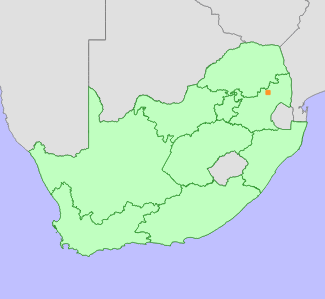|
Scientific Name | Disa clavicornis H.P.Linder |
Higher Classification | Monocotyledons |
Family | ORCHIDACEAE |
National Status |
Status and Criteria | Endangered D |
Assessment Date | 2012/09/11 |
Assessor(s) | L. Grobler, D. McMurtry, S. Burns, J. Grobler & L. von Staden |
Justification | Occurs as small stands of scattered individuals within a limited area centred around Mount Anderson (EOO <10 km²). Fewer than 250 mature individuals exist. It is potentially threatened by invasive alien plants and mining. |
Distribution |
Endemism | South African endemic |
Provincial distribution | Mpumalanga |
Range | Mount Anderson. |
Habitat and Ecology |
Major system | Terrestrial |
Major habitats | Long Tom Pass Montane Grassland |
Description | Grasslands above 2000 m, in well-drained soils between rocks and in marshy areas. |
Threats |
| This species is mainly threatened by habitat loss to pine plantations, which in some parts reach right to the top of the mountain and has caused past declines in this species. Escaped seedlings poses an ongoing threat of habitat degradation.
Mining and prospecting related activities are a serious threat to this species. Prospecting rights have been granted to a 300 000 ha section of Mount Anderson (M. Lotter, pers. comm. 2006). Should mining applications be granted, this would have serious implications for this species, and could lead to a rapid decline to extinction.
Agricultural activities are also leading to habitat loss and degradation in parts of this species' habitat, in particular cattle grazing within one of the wetlands where it occurs. |
Population |
This species occurs only as scattered individuals within a very small area centred around Mount Anderson, and is being surveyed annually. Plants do not flower every year, and in some years no flowering individuals can be located. The species has quite conspicuous blue flowers, and it is very unlikely that many individuals could have been overlooked. Flowering is not related to fires as flowers have been seen in burnt and unburnt grasslands, and it is not known whether rainfall or any other environmental factors affect flowering. The population is estimated to number fewer than 250 mature individuals.
|
Population trend | Stable |
Assessment History |
Taxon assessed |
Status and Criteria |
Citation/Red List version | | Disa clavicornis H.P.Linder | EN D | Raimondo et al. (2009) | | Disa clavicornis H.P.Linder | CR B1B2abc | Victor (2002) | | Disa clavicornis H.P.Linder | Vulnerable | Hilton-Taylor (1997) | |
Bibliography |
Hilton-Taylor, C. 1997. Red Data List of southern African plants. 2. Corrections and additions. Bothalia 27(2):195-209.
Linder, H.P. 1984. A new species of Disa (Orchidaceae). Journal of South African Botany 50(2):261-263.
Linder, H.P. and Kurzweil, H. 1999. Orchids of southern Africa. A.A. Balkema, Rotterdam.
Raimondo, D., von Staden, L., Foden, W., Victor, J.E., Helme, N.A., Turner, R.C., Kamundi, D.A. and Manyama, P.A. 2009. Red List of South African Plants. Strelitzia 25. South African National Biodiversity Institute, Pretoria.
Victor, J.E. 2002. South Africa. In: J.S. Golding (ed), Southern African plant Red Data Lists. Southern African Botanical Diversity Network Report 14 (pp. 93-120), SABONET, Pretoria.
|
Citation |
| Grobler, L., McMurtry, D., Burns, S., Grobler, J. & von Staden, L. 2012. Disa clavicornis H.P.Linder. National Assessment: Red List of South African Plants version 2024.1. Accessed on 2025/10/19 |
 Comment on this assessment
Comment on this assessment


